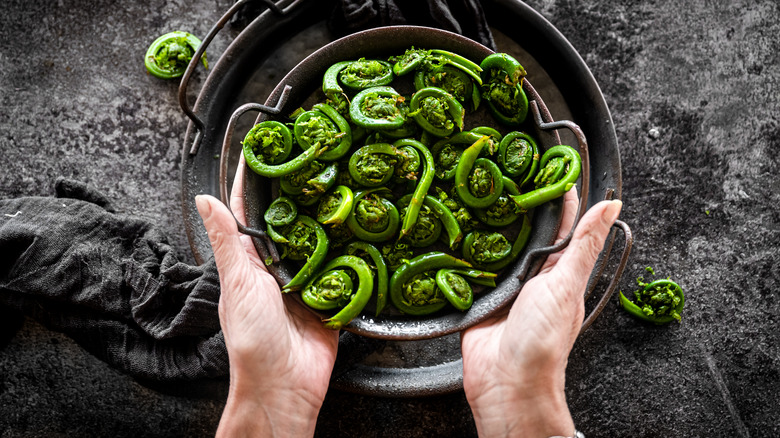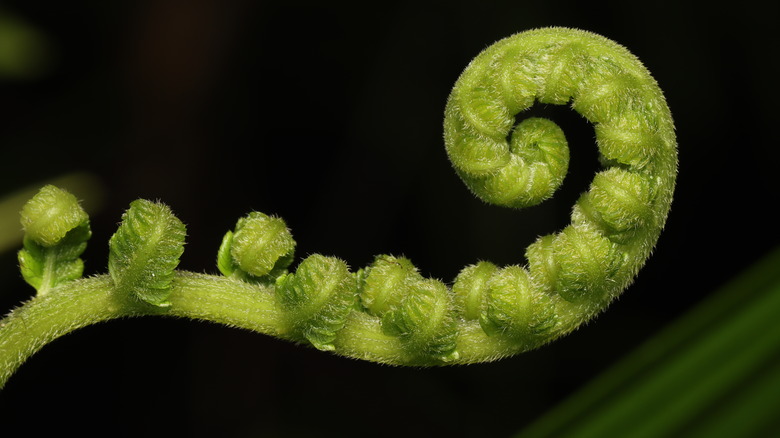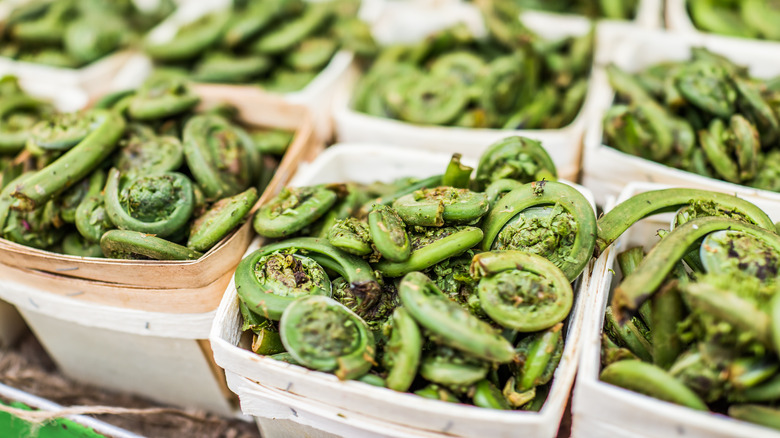It's Fiddlehead Season. Here's How To Eat The Fancy Vegetable Safely
Many chefs and foodies have mused that we have taste buds in our eyes, underscoring that sight is typically the first sense we use to evaluate food. When we encounter a particularly eye-catching item, its edible potential can be irresistible, which is true for the fiddlehead. A fiddlehead is a young fern that, in the early stages of its life, grows in a tight coil that closely resembles the head of a stringed instrument such as a — go figure — fiddle. As the fern continues to grow, it will gradually unfurl into the type of large frond you've probably seen countless times in the wild, but this nascent stage, when it is all curled up, is when the fern has the most culinary potential.
Fiddleheads are only available briefly each year, typically around May, and they disappear fast because the ferns keep growing. You're in for a treat if you get them within this narrow window. Fiddleheads have a mildly sweet flavor often likened to asparagus, but their texture is crisper, more akin to a green bean. Many people also sense hints of artichoke and earthy mushrooms in them, a truly unique flavor profile. But cooking with fiddleheads can be a tricky business. Prepare them correctly, and you've got a seasonal delight that will catch the eye of any dinner guest but make a wrong move, and you could get sick.
How to safely cook fiddleheads
To prevent you from getting sick, fiddleheads need to be prepared in a particular way. First, you should thoroughly wash them. The ferns are sometimes coated in a very thin papery sheath, which you will need to rub off. The critical step for eliminating potential toxins is to boil the fiddleheads for at least 10 minutes (you can go up to 15, but beyond that point, they may lose their snappy texture and become limp). Drain the fiddleheads and dump them into an ice water bath to prevent them from further cooking, and add them to your recipe of choice.
Fiddleheads are best prepared simply, allowing their unique flavor to shine. They are frequently compared to asparagus and broccoli rabe, and those comparisons provide great inspiration for how you can cook them. Our simple recipe for sautéed asparagus with lemon and parmesan would adapt well with fiddleheads, as would steaming or braising them. You could plate your sautéed fiddleheads with a dollop of hollandaise sauce or dress them in a simple vinaigrette. For a more significant culinary challenge, you could make your own pickled fiddleheads. The possibilities are manifold; just remember first to boil them properly.
Uncooked ferns can be toxic
Why is it so important to cook fiddleheads in a particular way? Many ferns have toxic compounds whose effects can range from unpleasant to downright dangerous. In North America, fiddleheads typically come from the ostrich fern, which is generally considered safe to eat. Other types of ferns are consumed, but they are less reliable. One popular global variety is the bracken fern, which is said to have a hint of almond in the flavor. However, bracken ferns contain high concentrations of a carcinogenic compound called ptaquiloside. Other, less common types of fiddleheads could pose similar dangers, which is why you should only eat fiddleheads harvested from ostrich ferns.
Even the ostrich fern can pose a risk, though not nearly as severe as the case of the bracken fern. The Centers for Disease Control and Prevention (CDC) considers ostrich ferns to be non-toxic and safe for consumption as long as they are adequately cooked. Raw or undercooked ostrich ferns have the potential to cause food poisoning. In 1994, a restaurant in Steuben County, New York, served undercooked ostrich fern fiddleheads, causing a widespread outbreak of food poisoning. Diners reported nausea, vomiting, and diarrhea as their primary symptoms. That very same year, a similar outbreak occurred amongst diners at a restaurant chain in multiple Canadian provinces. Fortunately, avoiding such issues is easy if you properly cook your fiddleheads.


